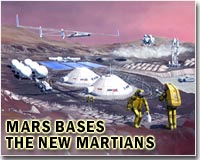 |
Berlin, Germany (SPX) Feb 11, 2011 'Half-time' for Mars 500; on 12 February 2011, after a 250-day simulated flight to Mars, three crewmembers will land on the Red Planet. They will climb out of their isolation pod two days later at the Moscow Institute for Biomedical Problems (IBMP) and begin a simulated exploration of Mars. Their eight-month return journey will commence in early March. "The 11 German experiments carried out so far have been completed with extreme professionalism and high accuracy," says Peter Graf from the German Aerospace Center (Deutsches Zentrum fur Luft- und Raumfahrt; DLR), who is responsible for managing the German part of the project. When the Russian Alexandr Smoleevsky, and the Italian Diego Urbina disembark from their landing module wearing their space suits On February 14, they will already have spent a long time in isolation. Their simulated journey to Mars began on 3 June 2010, as the hatch behind them closed, marking the start of the longest ever space simulation experiment. "All six crew members were in excellent physical condition," explains Peter Graf. The 'spacecraft' that the six men from Russia, Europe and China are currently living in has an area of 550 square metres. The cosmonauts are not only following a strict schedule including precise experiments, maintenance work and fitness training, but their nutrition is also planned, right down to the last detail. Until 8 February 2011, German management was in charge of devising their diet- researcher Jens Titze and his team developed detailed nutrition plans for the first half of the mission. Until the end of the mission in November 2011, the crew's menu will be under Russian management, and will include astronaut food, as well as Russian and Korean products.
Longest-ever metabolism study "A reduction in salt intake led to a significant fall in blood pressure, even in the healthy volunteers," explains Jens Titze, from Erlangen-Nuremberg University. This shows that low sodium diets not only benefit those with kidney or blood pressure conditions but, in the long-term, could help prevent heart attacks, strokes and arteriosclerosis. Titze gradually reduced the daily salt intake of the 'cosmonauts' during the course of the world's longest metabolism study, while keeping all other nutrients unchanged. The results obtained in the isolation experiments are expected to help in the reduction of blood pressure under more normal circumstances, as part of future clinical studies in which the Mars 500 menu will be implemented in everyday conditions. At the same time, scientists from the DLR Institute of Aerospace Medicine are researching other areas, including the link between salt intake and bone metabolism, as well as the spread of microorganisms in an enclosed environment.
Influence on the immune system and the natural biological rhythm of humans Stefan Schneider from the German Sports University in Cologne has been able to confirm the positive effects of sport in the Mars 500 volunteers. "There is a clear improvement in their cognitive performance." In addition, sport has also contributed to an increase in their level of self-assurance. The researchers' testing methods included the use of an iPod on board to evaluate the cosmonauts' cognitive performance. Other initial results include those from the study of human circadian rhythms - that is, the biological and psychological processes in the body that follow a natural cycle, often the length of a day. Researchers had expected to see these rhythms compromised by factors such as reduced physical activity, being in a confined space or the change in the light-dark cycle, especially during long-term flights. Initial measurements of core body temperature during isolation confirm this: "The preliminary results indicate that, although the circadian rhythm remains intact at first, the fluctuation of core body temperature substantially decreases," summarises Hanns-Christian Gunga from Charite Berlin. The journey continues for the six cosmonauts; after three walks on the simulated surface of Mars, Aleksandr Smoleevsky, Diego Urbina and Wang Yue will return from the landing module back to the 'spaceship' on 27 February. The return flight will last another eight months, with the hatch to the outside world opening once again on 5 November 2011.
Share This Article With Planet Earth
Related Links DLR Mars News and Information at MarsDaily.com Lunar Dreams and more
 Virtual Mars mission approaching 'landing'
Virtual Mars mission approaching 'landing'Moscow (UPI) Feb 2, 2011 The first full-duration simulation of a manned voyage to Mars has reached virtual Mars after 244 days of virtual interplanetary flight, Russian officials said. Mars500, an international study of the psychological and technical issues involved in long spaceflights, has been running for more than eight months in hermetically sealed modules imitating a Mars spacecraft at the Institute of B ... read more |
|
| The content herein, unless otherwise known to be public domain, are Copyright 1995-2010 - SpaceDaily. AFP and UPI Wire Stories are copyright Agence France-Presse and United Press International. ESA Portal Reports are copyright European Space Agency. All NASA sourced material is public domain. Additional copyrights may apply in whole or part to other bona fide parties. Advertising does not imply endorsement,agreement or approval of any opinions, statements or information provided by SpaceDaily on any Web page published or hosted by SpaceDaily. Privacy Statement |